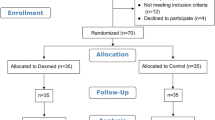Abstract
Purpose
Hypertensive patients exhibit exaggerated cardiovascular responses to tracheal extubation. This study was undertaken to examine the inhibitory effects of calcium channel blockers, nicardipine and diltiazem, on haemodynamic changes after tracheal extubation.
Methods
Sixty hypertensive patients (ASA physical status II) undergoing elective orthopaedic (upper and lower extremity) surgery received, in a randomized, double-blind manner, 30 μg·kg−1 nicardipine, 0.2 mg·kg−1 diltiazem or saline (as a control) (n = 20 of each) iv before tracheal extubation. Changes in heart rate (HR), mean arterial pressure (MAP) and rate-pressure product (RPP) were measured before and after tracheal extubation.
Results
The HR, MAP and RPP increased after tracheal extubation in the control group (P < 0.05). The increases in these haemodynamic variables were attenuated with nicardipine or diltiazem. The inhibitory effects of diltiazem on these cardiovascular responses to tracheal extubation were greater than those of nicardipine (HR; 86 ±7vs 101 ± 10, RPP; 1 1437 ± 1575vs 14675 ± 2874, mean ± SD,P < 0.05).
Conclusion
Compared with nicardipine, administration of diltiazem produced greater attenuating the circulatory responses to tracheal extubation in hypertensive patients.
Résumé
Objectif
Les patients hypertendus ont des réactions cardiovasculares exagérées lors de l’extubation endotrachéale. La présente étude a été réalisée pour évaluer l’effet des inhibiteurs caldques, nicardipine et diltiazem, sur les changements hémodynamiques qui suivent l’extubation endotrachéale.
Méthode
Soixante patients hypertendus (d’état physique ASA II) subissant une chirurgie orthopédique élective (au membre supérieur et inférieur) ont reçu, de façon aléatoire et en double aveugle, 30 μg·kg−1 de nicardipine, 0,2 mg·kg−1 de diltiazem ou une solution saline (solution témoin) (n = 20 dans chaque groupe) i.v. avant l’extubation endotrachéale. Les changements de fréquence cardiaque (FC), de tension artérielle (TA) et de produit de la fréquence par la tension (PFT) ont été mesurés avant et après l’extubation.
Résultats
Les FC, TA et PFT ont augmenté après l’extubation dans le groupe témoin (P < 0,05). L’augmentation de ces variables hémodynamiques a été atténuée avec la nicardipine ou le diltiazem. Les effets inhibiteurs du diltiazem sur ces réponses cardiovasculaires à l’extubation endotrachéale ont été plus importants que ceux de la nicadipine (FC; 86 ± 7vs 101 ± 10, PFT; 11 437 ± 1 575vs 14 675 ± 2 874, moyenne ± écart-type,P < 0,05).
Conclusion
En comparaison avec la nicardipine, l’administration du diltiazem a produit une plus grande atténuation des réactions circulatoires à l’extubation endotrachéale chez des patients hypertendus.
Similar content being viewed by others
References
Hartley M, Vaughan RS. Problems associated with tracheal extubation. Br J Anaesth 1993; 71: 561–8.
Bidwai AV, Bidwai VA, Rogers CR, Stanley TH. Bloodpressure and pulse-rate responses to endotracheal extubation with and without prior injection of lidocaine. Anesthesiology 1979; 51: 171–3.
Dyson A, Isaac PA, Pennant JH, Giesecke AH, Lipton JM. Esmolol attenuates cardiovascular responses to extubation. Anesth Analg 1990; 71: 675–8.
Fuhrman TM, Ewell CL, Pippin WD, Weaver JM. Comparison of the efficacy of esmolol and alfentanil to attenuate the hemodynamic responses to emergence and extubation. J Clin Anesth 1992; 4: 444–7.
Nishina K, Mikawa K, Maekawa N, Obara H. Fentanyl attenuates cardiovascular responses to tracheal extubation. Acta Anaesthesiol Scand 1995; 39: 85–9.
Nishina K, Mikawa K, Shiga M, Maekawa N, Obara H. Prostaglandin E1 attenuates the hypertensive response to tracheal extubation. Can J Anaesth 1996; 43: 678–83.
Nishina K, Mikawa K, Maekawa N, Obara H. Attenuation of cardiovascular responses to tracheal extubation with diltiazem. Anesth Analg 1995; 80: 1217–22.
Mikawa K, Obara H, Kusunoki M. Effect of nicardipine on the cardiovascular response to tracheal intubation. Br J Anaesth 1990; 64: 240–2.
Omote K, Kirita A, Namiki A, Iwasaki H. Effects of nicardipine on the circulatory responses to tracheal intubation in normotensive and hypertensive patients. Anaesthesia 1992; 47: 24–7.
Prys-Roberts C, Green LT, Meloche R, Foëx P. Studies of anaesthesia in relation to hypertension. II: Haemodynamic consequences of induction and endotracheal intubation. Br J Anaesth 1971; 43: 531–47.
Fox EJ, Sklar GS, Hill CH, Villaneuva R, King BD. Complications related to the pressor response to endotracheal intubation. Anesthesiology 1977; 47: 524–5.
Mikawa K, Ikegaki J, Maekawa N, Goto R, Kaetsu H, Obara H. The effect of diltiazem on the cardiovascular response to tracheal intubation. Anaesthesia 1990; 45: 289–93.
Fujii Y, Toyooka H, Tanaka H. Cardiovascular responses to tracheal extubation or LMA removal in normotensive and hypertensive patients. Can J Anaesth 1997; 44: 1082–6.
Lowrie A, Johnston PL, Fell D, Robinson SL. Cardiovascular and plasma catecholamine responses at tracheal extubation. Br J Anaesth 1992; 68: 261–3.
Robinson BF. Relation of heart rate and systolic blood pressure to the onset of pain in angina pectoris. Circulation 1967; 35: 1073–83.
Cokkinos DV, Voridis EM. Constancy of pressure-rate product in pacing-induced angina pectoris. Br Heart J 1976; 38: 39–12.
Author information
Authors and Affiliations
Additional information
A retraction note to this article is available at http://dx.doi.org/10.1007/s12630-013-9958-y.
This article has been retracted due to two reasons: Many variables reported in the studies are exceedingly unlikely. The author's institution is not able to attest to the integrity of the study and/or the data conducted under its auspices.
An erratum to this article is available at http://dx.doi.org/10.1007/s12630-013-9958-y.
About this article
Cite this article
Fujii, Y., Kihara, Si., Takahashi, S. et al. RETRACTED ARTICLE: Calcium channel blockers attenuate cardiovascular responses to tracheal extubation in hypertensive patients. Can J Anesth/J Can Anesth 45, 655–659 (1998). https://doi.org/10.1007/BF03012096
Accepted:
Published:
Issue Date:
DOI: https://doi.org/10.1007/BF03012096




